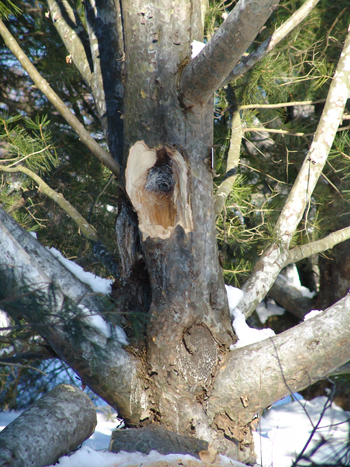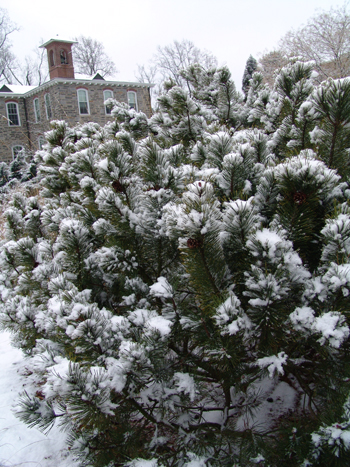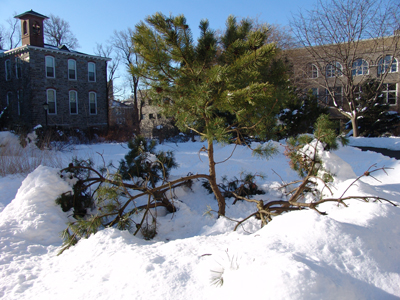Snow Load on Plants

After the large snow fall we had on February 5th and 6th you have probably looked outside and have observed many of your prized plants are engulfed in snow. In most cases the snow will fall off the plants and they will spring back to their natural and original shape. However, there are some plants which are especially vulnerable to heavy snows. Several pines including the lacebark pine (Pinus bungeana) and especially the Eastern white pine (Pinus strobus) can have large branches snapping off at the trunk from the weight of the snow.
Most evergreen conifers, however, that have a strong central leader, such as: Japanese red-cedar (Cryptomeria); fir (Abies); spruce (Picea); and cedar (Cedrus) can be covered in snow without it causing a serious effect. Multiple trunked conifers, such as, juniper (Juniperus); Leyland cypress (xCuprocyparis) and arborvitae (Thuja) often have the multiple leaders splay open in a heavy snow. In the case of the aforementioned conifers , it is advantageous to try to knock the snow from the branches to avoid the leaders from splaying open. The damage can be irreparable from a heavy snow load.

Pinus mugo ' Enci' in the John W. Nason garden after an inch snow on February 3. photo credit: R. Robert
Most shrubs have an amazing capacity to recover from very heavy snows. Multi-stemmed broadleaved evergreens such as inkberry (Ilex glabra); heavenly bamboo (Nandina domestica); common boxwood (Buxus sempervirens); Mahonia japonica; and M. bealei “catch” the snow. This often causes the branches to open up and be pinned to the ground with the weight of the snow. If you are fearful that the weight of the snow may be doing damage, gently brush the snow from the plants with a broom. However, I have found that allowing the snow to melt and alleviate the weight, the plants will spring back without any permanent damage to their structure.

The same Pinus mugo 'Enci' as pictured above after a 28.2 snow on February 6. The branches are splayed open from snow load. Hopefully this plant will spring back after snow melt. photo credit: R. Robert
All perennials will be perfectly fine under the layer of snow. Even newly emerging flowers such as the Lenten rose (Helleborus xhybridus) will be insulated by the snow and flower in profusion once the snow has melted.
Once the snow begins to melt gardeners should be mindful of snow and giant icicles melting from roofs and dislodging with great force and weight. This can often crush the plants below. Unfortunately, like the large breaking branches of the lacebark pine and the Eastern white pine there is not a lot that can be done to avoid is collateral damage. However, I suggest don’t park your car under a white pine during a snow storm!





Andrew Bunting
Posted at 13:45h, 11 FebruaryAfter this past snow (now almost 50 inches in a week) we have observed how plants really fair in heavy snows. As mentioned in the blog pines, Pinus are very vulnerable. We have especially seen extensive damage to Pinus bungean, lacebark pine. Also, several of the true cedars, Cedrus suffered considerable damage when their branches became weighted down with too much snow and simply snapped. The breaking branches then fell on lower branches also breaking them. Several broad-leaved trees such as American holly, Ilex opaca and Southern magnolia, Magnolia grandiflora have had large branches break out of them. There has been so much snow that many shrubs have splayed open. If you feel your plants, especially shrubs, are likely to break under the weight of the snow then you can gently shake the shrub branches to alleviate the snow load.
Andrew Bunting, Curator
PlantingOaks
Posted at 15:04h, 11 FebruaryWe have some very large old yews at our house. While they definitely have the ‘multiple leader’ problem, they are apparently flexible enough that branches as thick as my arm bend under the snow load until they touch the ground but do not break. They definitely look a mess under heavy snow, but always spring back. I guess that’s why they were used for making bows?